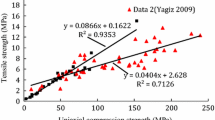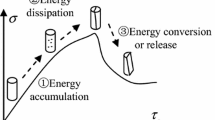Abstract
Brittleness is an important rock material property, and its accurate evaluation has guiding significance in construction as well as in disaster prevention and reduction. Considering the limitations of the existing brittleness indices, a new brittleness index based on the overall stress–strain process of a rock mass is established that considers both the stress growth rate between the peak stress and the crack initiation stress before the peak, as well as the stress descent rate after the peak. Uniaxial and triaxial compression tests were conducted to evaluate the new index. The results of the tests show that the new index can accurately determine the rock brittleness according to the prepeak stress–strain curve under uniaxial loading system conditions, which compensates for the limitation of inaccurate postpeak curves for brittle rock. Under triaxial compression conditions, the new index more clearly represents the influence of the confining pressure on the brittleness of marble. The reliability and comprehensiveness of the new index are verified, and these research results may improve the existing evaluation of rock brittleness.
















Similar content being viewed by others
Abbreviations
- B :
-
Brittleness index
- σ 1 :
-
Major principal stress
- σ 3 :
-
Minor principal stress
- σ c :
-
Uniaxial compressive strength
- σ t :
-
Splitting tensile strength
- σ i :
-
Crack initiation stress
- τ p :
-
Peak compressive strength
- τ r :
-
Residual compressive strength
- ε p :
-
Peak strain
- ε r :
-
Residual strain
- ε :
-
Axial strain
- \( {\varepsilon}_c^p \) :
-
Plastic strain necessary for cohesion loss
- \( {\varepsilon}_f^p \) :
-
Plastic strain necessary for frictional strengthening
- W r :
-
Recoverable strain energy
- W :
-
Total strain energy
- E :
-
Elasticity modulus of prepeak
- ν :
-
Poisson’s ratio
- M :
-
Elasticity modulus of postpeak
- k ac :
-
Stress slope of postpeak
- φ :
-
Internal friction angle
- RTRI :
-
Rock tenacity rating index
- S F :
-
Stiffness factor
- G F :
-
Texture factor
- F F :
-
Foliation factor
- H μ :
-
Microhardness of rock
- H :
-
Macrohardness of rock
- K IC :
-
Fracture toughness
- S 20 :
-
Proportion of detritus whose particle size is smaller than 11.2mm
- q :
-
Proportion of detritus whose particle size is smaller than 0.6mm
- F max :
-
Maximum impact load
- P :
-
Penetration depth
- P dec :
-
Increment load
- P inc :
-
Attenuation load
References
Altindag R (2002) The evaluation of rock brittleness concept on rotary blast hold drills. J South Afr Inst Min Metall 102:61–66. https://hdl.handle.net/10520/AJA0038223X_2763
Altindag R (2003) Correlation of specific energy with rock brittleness concepts on rock cutting. J South Afr Inst Min Metall 103:163–171. https://hdl.handle.net/10520/AJA0038223X_2948
Altindag R (2010) Assessment of some brittleness indexes in rock-drilling efficiency. Rock Mech Rock Eng 43:361–370. https://doi.org/10.1007/s00603-009-0057-x
Baron LI, Loguntsov BM, Posin EZ (1962) Determination of properties of rocks. Gozgotekhizdat, Moscow (in Russian)
Bishop AW (1967) Progressive failure with special reference to the mechanism causing it. In: Proceedings of the Geotechnical Conference, Oslo, Norway, pp 142–150
Blindheim OT, Bruland A (1998) Boreability testing. In: Norwegian TBM tunnelling: 30 years of experience with TBMs in Norwegian tunnelling. Norwegian Soil and Rock Engineering Association, pp 21-27
Coates DF, Parsons RC (1966) Experimental criteria for classification of rock substances. Int J Rock Mech Min Sci Geomech Abstr 3:181–189. https://doi.org/10.1016/0148-9062(66)90022-2
Copur H, Bilgin N, Tuncdemir H et al (2003) A set of indices based on indentation tests for assessment of rock cutting performance and rock properties. J South Afr Inst Min Metall 103(9):589–599. https://hdl.handle.net/10520/AJA0038223X_2840
Diederichs MS (2003) Manuel rocha medal recipient rock fracture and collapse under low confinement conditions. Rock Mech Rock Eng 36(5):339–381. https://doi.org/10.1007/s00603-003-0015-y
Diederichs MS (2007) The 2003 Canadian Geotechnical Colloquium: mechanistic interpretation and practical application of damage and spalling prediction criteria for deep tunnelling. Can Geotech J 44(9):1082–1116. https://doi.org/10.1139/T07-033
Gong QM, Zhao J (2007) Influence of rock brittleness on TBM penetration rate in Singapore granite. Tunn Undergr Space Technol 22(3):317–324. https://doi.org/10.1016/j.tust.2006.07.004
Hajiabdolmajid V, Kaiser P (2003) Brittleness of rock and stability assessment in hard rock tunneling. Tunn Undergr Space Technol 18:35–48. https://doi.org/10.1016/S0886-7798(02)00100-1
Heidari M, Khanlari GR, Torabi-Kaveh M et al (2014) Effect of porosity on rock brittleness. Rock Mech Rock Eng 47:785–790. https://doi.org/10.1007/s00603-013-0400-0
Hetenyi M (1966) Handbook of experimental stress analysis. Wiley, New York, p 15
Hoek E, Carranza-Torres CT, Corkum B (2002) Hoek–Brown failure criterion—2002 edition. In: Proceedings of the 5th North American Rock Mechanics Symposium and 17th Tunneling Association of Canada Conference, Toronto, Canada, July 2002. https://www.rocscience.com/help/rocdata/pdf_files/theory/Hoek-Brown_Failure_Criterion-2002_Edition.pdf
Honda H, Sanada Y (1956) Hardness of coal. Fuel 35:451–461
Hucka V, Das B (1974) Brittleness determination of rocks by different methods. Int J Rock Mech Min Sci Geomech Abstr 11(10):389–392. https://doi.org/10.1016/0148-9062(74)91109-7
Kahraman S (2002) Correlation of TBM and drilling machine performances with rock brittleness. Eng Geol 65(4):269–283. https://doi.org/10.1016/S0013-7952(01)00137-5
Lawn BR, Marshall DB (1979) Hardness, toughness, and brittleness: an indentation analysis. J Am Ceram Soc 62(7–8):347–350. https://doi.org/10.1111/j.1151-2916.1979.tb19075.x
Li QH, Chen M, Jin Y et al (2012) Indoor evaluation method for shale brittleness and improvement. Chin J Rock Mech Eng 31(8):1680–1685 (in Chinese)
Martin CD, Chandler NA (1994) The progressive fracture of Lac du Bonnet granite. Int J Rock Mech Min Sci Geomech Abstr 31(6):643–659. https://doi.org/10.1016/0148-9062(94)90005-1
Meng FZ, Zhou H, Zhang CQ et al (2015) Evaluation methodology of brittleness of rock based on post-peak stress–strain curves. Rock Mech Rock Eng 48:1787–1805. https://doi.org/10.1007/s00603-014-0694-6
Miskimins JL (2012) The impact of mechanical stratigraphy on hydraulic fracture growth and design considerations for horizontal wells. Bulletin 91(4):475–499
Morley A (1954) Strength of materials, 11th edn. Longmans, Green, London, p 532
Obert L, Duvall WI (1967) Rock mechanics and the design of structures in rock. Wiley, New York, p 278
Protodyakonov MM (1963) Mechanical properties and drillability of rocks. In: Proceedings of the 5th Symposium on Rock Mechanics, University of Minnesota, May 1962, pp 103–118
Quinn JB, Quinn GD (1997) Indentation brittleness of ceramics: a fresh approach. J Mater Sci 32(16):4331–4346. https://doi.org/10.1023/A:1018671823059
Ramsey JG (1967) Folding and fracturing of rocks. McGraw-Hill, London, p 289
Reichmuth DR (1967) Point load testing of brittle materials to determine tensile strength and relative brittleness. In: Proceedings of the 9th US Symposium on Rock Mechanics (USRMS), Golden, Colorado, April 1967. American Rock Mechanics Association (ARMA), pp 134–159
Rickman R, Mullen MJ, Petre JE et al (2008) A practical use of shale petrophysics for stimulation design optimization: all shale plays are not clones of the Barnett shale. In: Proceedings of the SPE Annual Technical Conference and Exhibition, Denver, Colorado, September 2008. Society of Petroleum Engineers. https://doi.org/10.2118/115258-MS
Rybacki E, Reinicke A, Meier T et al (2015) What controls the mechanical properties of shale rocks?—Part I: strength and Young’s modulus. J Pet Sci Eng 135:702–722. https://doi.org/10.1016/j.petrol.2015.10.028
Rybacki E, Meier T, Dresen G (2016) What controls the mechanical properties of shale rocks?—Part II: brittleness. J Pet Sci Eng 144:39–58. https://doi.org/10.1016/j.petrol.2016.02.022
Singh SP (1986) Brittleness and the mechanical winning of coal. Min Sci Technol 3(3):173–180. https://doi.org/10.1016/S0167-9031(86)90305-1
Suorineni FT, Chinnasane DR, Kaiser PK (2009) A procedure for determining rock-type specific Hoek–Brown brittle parameters. Rock Mech Rock Eng 42(6):849–881. https://doi.org/10.1007/s00603-008-0024-y
Tarasov BG, Potvin Y (2012) Absolute, relative and intrinsic rock brittleness at compression. Min Technol 121(4):218–225. https://doi.org/10.1179/1743286312Y.0000000015
Tarasov B, Potvin Y (2013) Universal criteria for rock brittleness estimation under triaxial compression. Int J Rock Mech Min Sci 59:57–69. https://doi.org/10.1016/j.ijrmms.2012.12.011
Wang Y, Li X, Wu YF et al (2014) Research on relationship between crack initiation stress level and brittleness indices for brittle rocks. Chin J Rock Mech Eng 33(2):264–275 (in Chinese). https://doi.org/10.13722/j.cnki.jrme.2014.02.003
Xia YJ, Li LC, Tang CA et al (2016) Rock brittleness evaluation based on stress dropping rate after peak stress and energy ratio. Chin J Rock Mech Eng 35(6):1141–1154 (in Chinese). https://doi.org/10.13722/j.cnki.jrme.2015.0803
Xia YJ, Li LC, Tang CA et al (2017a) A new method to evaluate rock mass brittleness based on stress–strain curves of class I. Rock Mech Rock Eng 50:1123–1139. https://doi.org/10.1007/s00603-017-1174-6
Xia YJ, Li LC, Tang CA et al (2017b) Experiment and numerical research on failure characteristic and brittleness index for reservoir sandstone. Chin J Rock Mech Eng 36(1):10–28 (in Chinese). https://doi.org/10.13722/j.cnki.jrme.2015.1407
Yagiz S (2006) An investigation on the relationship between rock strength and brittleness. In: Proceedings of the 59th Geological Congress of Turkey, Ankara, Turkey, March 2006. MTA General Directory Press, p 352
Yagiz S (2009) Assessment of brittleness using rock strength and density with punch penetration test. Tunn Undergr Space Technol 24(1):66–74. https://doi.org/10.1016/j.tust.2008.04.002
Yarali O, Kahraman S (2011) The drillability assessment of rocks using the different brittleness values. Tunn Undergr Space Technol 26(2):406–414. https://doi.org/10.1016/j.tust.2010.11.013
Yilmaz NG, Karaca Z, Goktan RM et al (2009) Relative brittleness characterization of some selected granitic building stones: influence of mineral grain size. Constr Build Mater 23(1):370–375. https://doi.org/10.1016/j.conbuildmat.2007.11.014
Yuan JL, Deng JG, Zhang DY et al (2013) Fracability evaluation of shale-gas reservoirs. Acta Pet Sin 3(1):523–527 (in Chinese)
Zhang J, Ai CH, Li YW et al (2017) Brittleness evaluation index based on energy variation in the whole process of rock failure. Chin J Rock Mech Eng 36(6):1326–1340 (in Chinese). https://doi.org/10.13722/j.cnki.jrme.2016.0839
Acknowledgements
This work is supported by the National Key R&D Program of China (2017YFC1501301) and the National Natural Science Foundation of China (grant nos. 41521002 and 41572283). This work is also supported by the Funding of Science and Technology Office of Sichuan Province (grant no. 2017TD0018) and the research fund of the State Key Laboratory of Geohazard Prevention and Geoenvironment Protection (no. SKLGP2018Z011).
Author information
Authors and Affiliations
Corresponding author
Rights and permissions
About this article
Cite this article
Chen, G., Jiang, W., Sun, X. et al. Quantitative evaluation of rock brittleness based on crack initiation stress and complete stress–strain curves. Bull Eng Geol Environ 78, 5919–5936 (2019). https://doi.org/10.1007/s10064-019-01486-2
Received:
Accepted:
Published:
Issue Date:
DOI: https://doi.org/10.1007/s10064-019-01486-2




